Île de Beauté – Island of Beauty. This is also what Corsica is called. You can expect stunningly beautiful landscapes, turquoise waters, fiery red cliffs, and traditional stone villages nestled into the mountains. As well as the finest sandy beaches and paradisiacal bays. Napoleon’s homeland is also a land of traditions and history, which you can discover on a stroll through the island’s towns.
History seems far from over, as the Corsicans still want to become independent from France. The mountains, the nature, the beautiful beaches, the ancient towns make Corsica very diverse. If you want, you can climb a mountain in the morning and lie on the beach in the afternoon. There really should be something for everyone here.
In total, we – that’s my dog Bali, my camper Frido, and I, Vanessa – spent 16 days in Corsica (not including travel there and back). A perfect time to stay in one place a little longer. In the following article, I would like to introduce you to my Corsica tour and give you my best travel tips.
- General information about Corsica
- Corsica tour: Our 16-day route
- Who is this Corsica tour suitable for?
- Stop 1: Arrival in Bastia & San Nicolao
- Stop 2: Vallée de la Restonica
- Stop 3: Calacuccia
- Stop 4: Porto
- Stop 5: Calanche Piana – Calcatoggio
- Stop 6: Abbartello
- Stop 7: Plage de la Tonnara
- Stop 8: Bonifacio
- Stop 9: Rondinara
- Stop 10: Fautea
- Stop 11: Solaro
- Stop 12: Aléria
- Getting there in Corsica
- When is the best time to travel to Corsica?
- How much does a Corsica round trip cost?
- Packing list – what should I not forget?
- Travel guide for Corsica
General information about Corsica
The island of Corsica, with a population of 341,000 (as of 2019), is located in the Mediterranean Sea, bordered to the north by the Ligurian Sea, to the east and south by the Tyrrhenian Sea, and to the west by the Western Mediterranean. Separated to the south by the Strait of Bonifacio lies the Italian island of Sardinia.
From north to south, the island measures 183 km and from east to west 83 km. Due to its numerous bays, Corsica also has a coastline of over 1,000 km. As one of the 18 regions of France, French is of course spoken here, but also Corsican (a language related to Italian).
Quick Facts Corsica:
- Population: 340,000
- Capital: Port city of Ajaccio
- Language: French, Corsican
- Currency: Euro
- Best time to visit: May & June, September & October
- Traffic: on the right
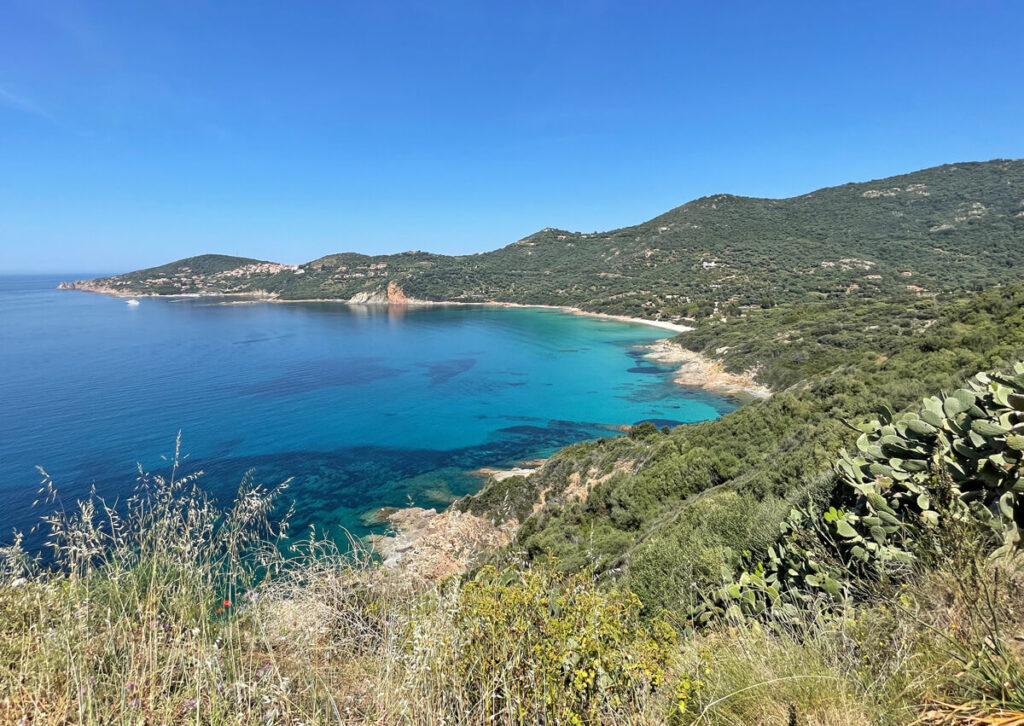
Corsica Round Trip: Our 16-Day Route
Generally, it is recommended to drive around Corsica counterclockwise. This way, you are on the west side and on the very winding roads, on the outside. 1) You have a better view and 2) you don’t have to worry about getting stuck on rocks. This is just a tip; you can, of course, drive in both directions. You’ll find more tips for driving in Corsica soon on the blog.
Like most people, I started in Bastia because that’s where the ferry docked. After a short stop on the coast, I first headed into the mountains of Corsica, where I made two stops. Then I continued along the west coast to Bonficaio and back along the east coast to Bastia.
Weather-wise, May was perfect for us, although it did get quite warm towards the end, which my dog Bali doesn’t like very much. Nevertheless, it cools down nicely in the evenings and isn’t too hot in the mornings. So we did most of the activities in the morning and late afternoon.
The traffic was also very relaxed. I always had a free choice of campsites, and there were generally not many people. Some squares and restaurants were even still closed, but this didn’t affect our experience, as there was always an alternative.
16-Day Corsica Tour
- 3 nights in San Nicolao
- 1 night in Vallee de la Restonica
- 1 night in Calacuccia
- 2 nights in Porto/Ota
- 1 night in Calcatoggio
- 1 night in Abbartello
- 1 night in Plage de la Tonnara
- 1 night in Rondinara
- 2 nights in Fautea
- 2 nights in Solaro
- 1 night in Aleria
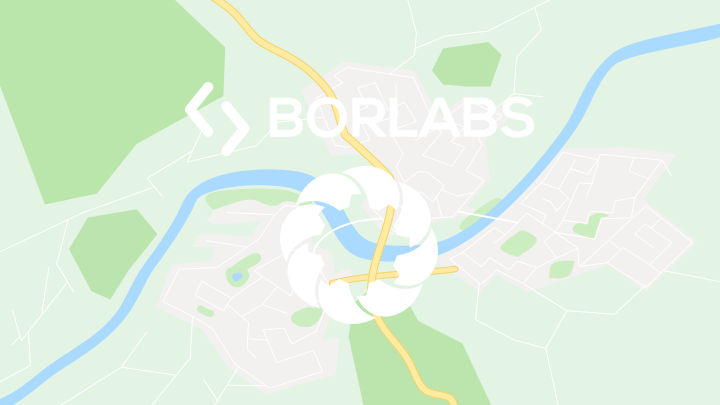
By loading the map, you accept Google’s privacy policy.
Learn more
Load map
Who is this Corsica tour suitable for?
Our tour is especially suitable for travelers who enjoy being active, for dog owners, and campers. Of course, I also lay on the beach once, but only as long as is possible with a dog. Otherwise, we did a lot of walking, and because we had our home on four wheels with us, we were sometimes only in one place for one night.
The distances in Corsica aren’t very great, but what might be a short 30 km can take an hour. You should definitely like driving and not be a nervous driver; it can get very tight at times, especially with a camper.
Stop 1: Arrival in Bastia & San Nicolao
We arrived in Bastia around 1:30 p.m. We skipped Bastia and quickly made our way out of the bustling city. I hadn’t booked a campsite in advance because we were on the island during the off-season. The first two campsites I visited were still closed, so we ended up at the Merendella campsite in San Nicolao.
We had free choice of sites and ended up standing under the trees on the beach. I immediately unpacked my SUP board because the sea was very calm. My dog, Bali, came along too. And so we spent three fairly relaxing days here. Perfect for arriving and acclimatizing.
The biggest highlight here was, of course, the beach right outside. However, after an hour’s leisurely stroll, you can reach a true paradise inland: a waterfall with a natural swimming pool. We were here very early in the morning and alone.


The waterfall is surrounded by dense trees, making it quite pleasant for dogs. However, you’ll spend most of your time walking in the sun. You can simply ask for directions at the campsite reception, as the waterfall doesn’t have a specific name.
Shops are located directly across the street, such as the small supermarket “Grandi Producteur fruits et legumes” with plenty of vegetables and fruit (bulk). The larger shops are a 20-minute walk along the main road.
Stop 2: Vallée de la Restonica
From San Nicolao, we went to Corte, 70 km away, and from there to the Vallée de la Restonica. The valley is located in the center of the island and is a very popular destination. There are so many things to do throughout the valley, such as canyoning, mountain biking, climbing, and hiking. There’s something for every outdoor enthusiast.
By the way: Did you know that Corsica has over 70 peaks over 2,000 meters high? It’s not for nothing that Corsica is also called the “mountain range in the sea”. The island consists largely of high mountains, with Mount Cinto (2,720 m) at its highest point.
I actually wanted to see the small town of Corte in the mountains, but parking was a bit problematic. It was also very hot, so I drove on. But it’s definitely worth seeing if you have a bit more patience, like me. It was a great drive to Corte.
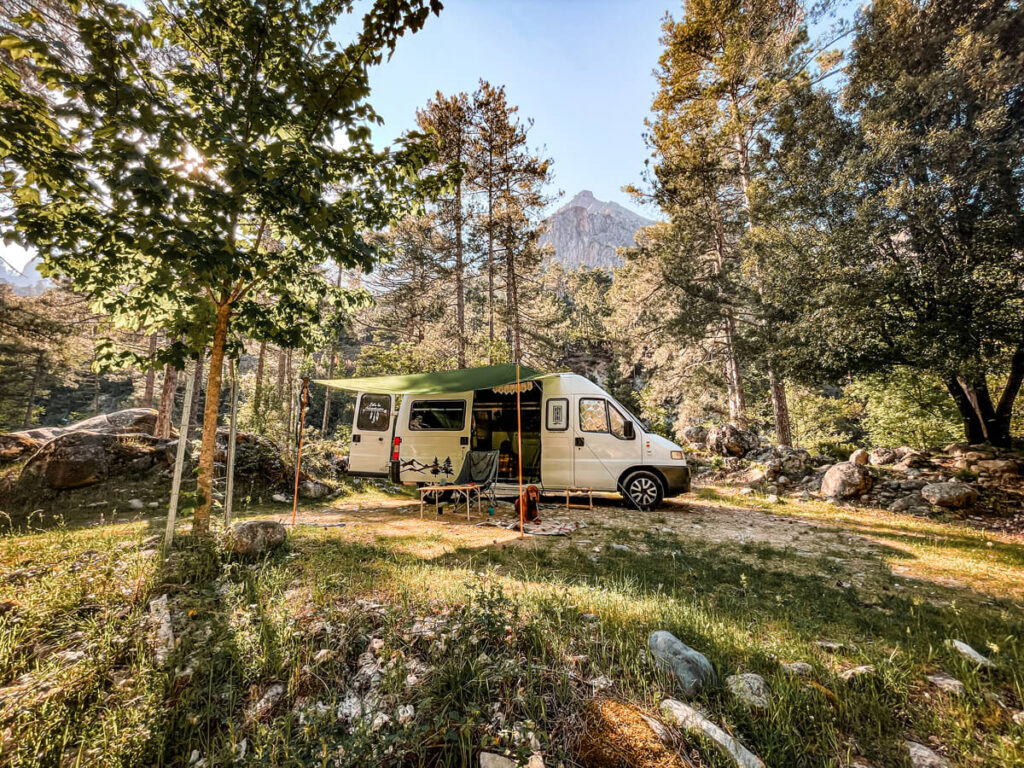
The road narrows considerably as you enter the valley. All traffic is free until you reach the Tuani campsite. From the campsite, and thus for the last 10 km, only cars/vans no wider than 1.9 m and no heavier than 4.5 t are permitted. During peak season, a shuttle runs to the end point, which is also the starting point for some hikes.
The next day, we hiked to Lac de Capitello at around 1,950 m, which was an absolute highlight of our Corsica tour. A stunning panorama awaited us, reminding me of Patagonia. A truly strenuous hike, but absolutely worth it! You can find a similar route here: Hike to Lac de Capitello.
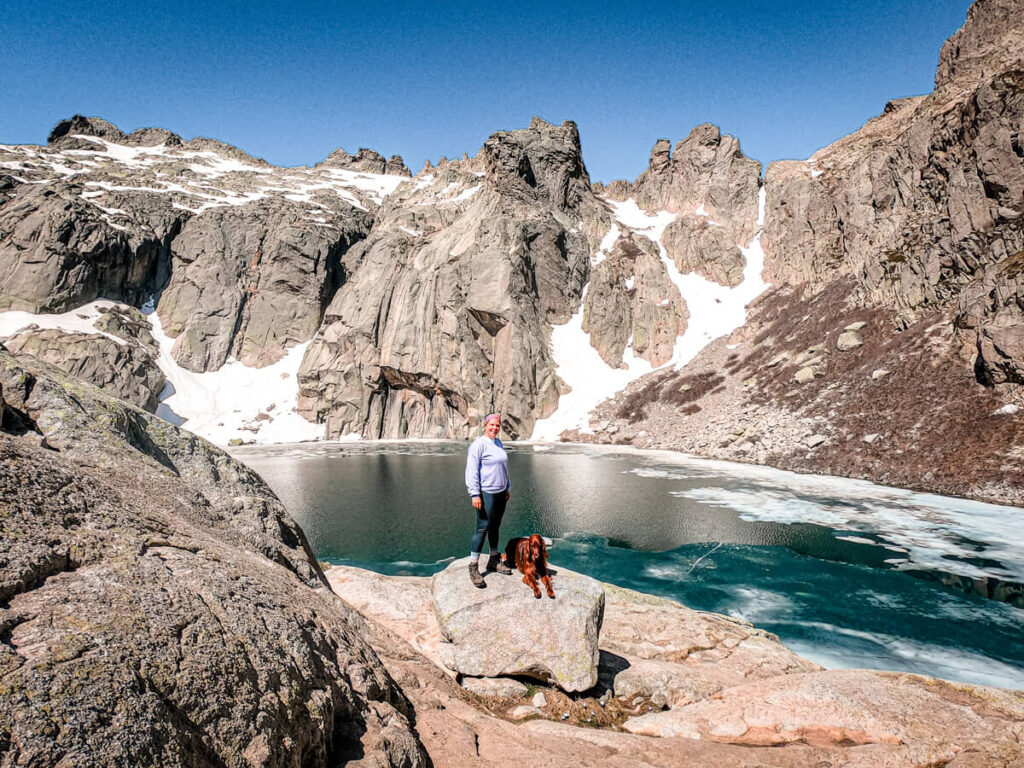
Stop 3: Calacuccia
Calauccia was “just” an overnight stop for us, as I didn’t want to drive too far after the hike. The Acquaviva Campsite is beautifully situated on the hillside, and you have partial views of the reservoir and Monte Cinto, the highest mountain in Corsica. Several hikes also start from here, but for us it was just a place to relax, and for that it was perfect.
Stop 4: Porto
From Caluccia we took the D84 via Evisa to Ota. An incredibly impressive route, and a little easier to drive than expected. But we also had very little traffic that day. We mostly encountered pigs, goats, and sheep.
I chose the Fontana a l’ora campsite, which is located just outside of Porto. There were beautiful sites with some privacy, a pool, and a small restaurant with delicious pizza. We took a trip to Porto’s beach here.
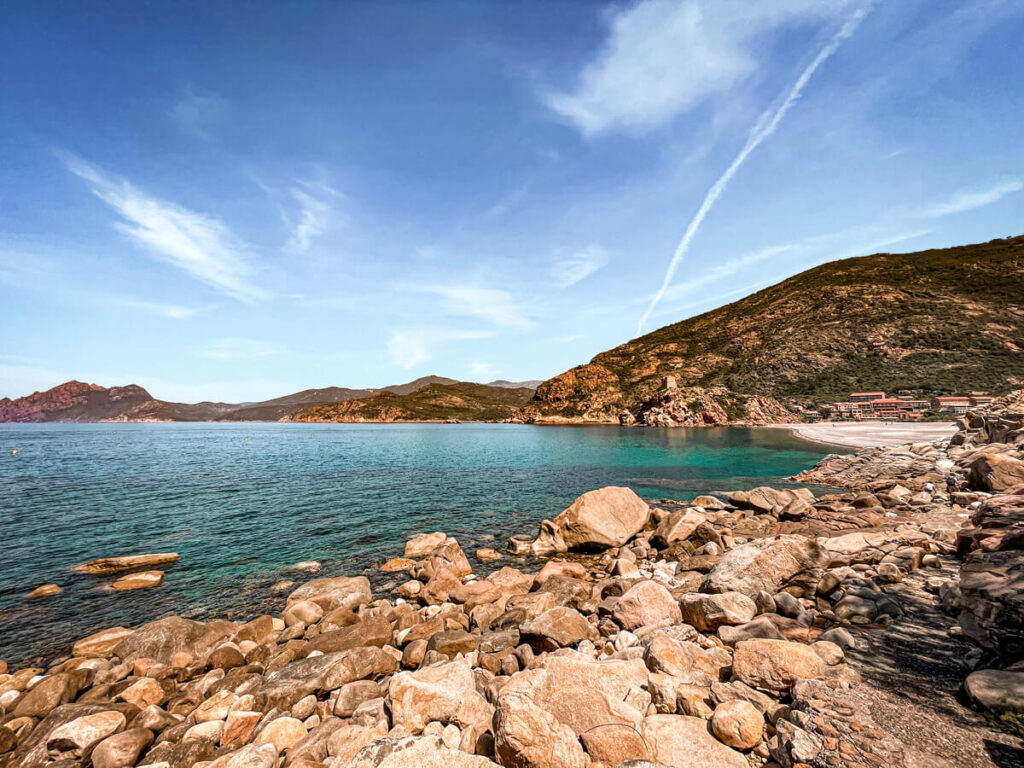
If you stand on the beach and look to your left, there’s a path along the rocks that takes about 30 minutes, offering fantastic views of the bay. There are also climbing routes on the rocks, and some sports enthusiasts were busy climbing here – right on the beach. By the way, there’s a great tour from Porto: Half-Day Trip to Scandola Reserve & Calanche de Piana*.
Stop 5: Calanche Piana – Calcatoggio
Les calanches de Piana – fjord-like bay. A rocky landscape of reddish granite, and pretty much the first thing that comes to mind when you do your initial research about Corsica. We set off relatively early from Porto and drove through the gigantic Calanche rocky landscape. I’d heard many horror stories about this route, especially regarding the oncoming traffic. We had chosen a good time and only encountered two vehicles coming the other way.
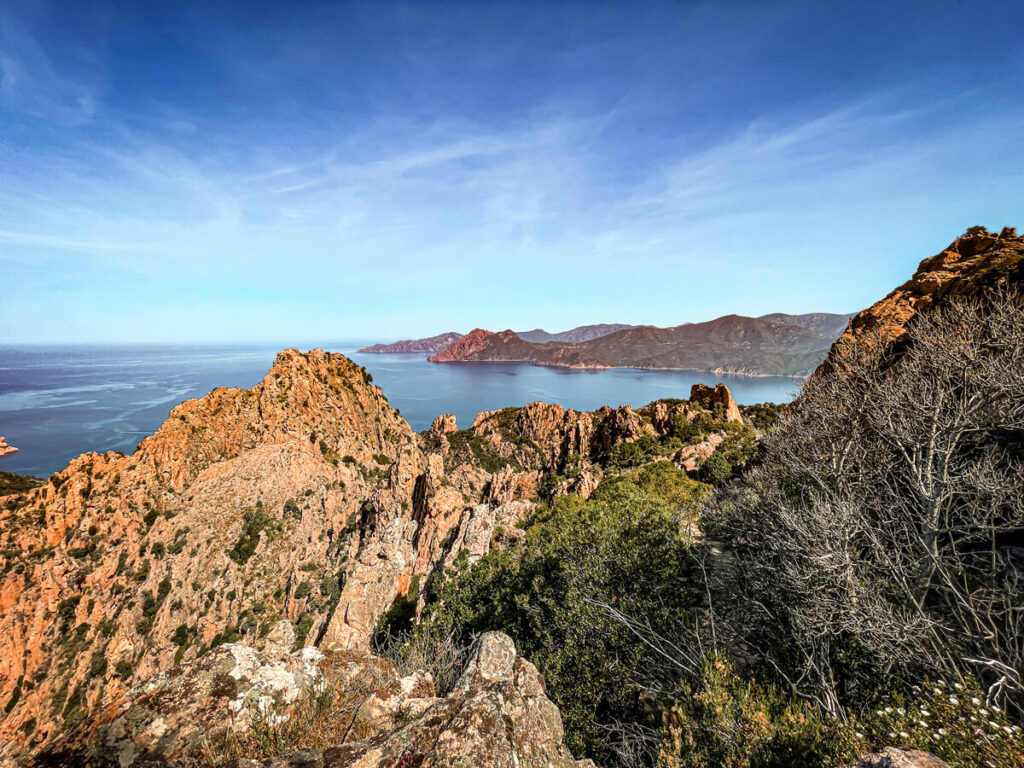
There are plenty of stopping bays to take photos. Here, driving counterclockwise was definitely the best option for me and my camper. At the end of the Calanche, there’s a hiking parking lot, from where various routes start for a closer look at the granite cliffs. At sunset, the red granite rocks are said to practically “glow.” However, it was too risky for me, as it would surely be busier then, and I wouldn’t have been able to get through so easily with the camper. We continued along the coast, amazed at every bend. Basically, you can just turn off the main road and find yourself at the next dream beach. We ended up at the A Marina campsite in the small town of Calcatoggio. A relatively small site right on the beach. We spent one night here. There were lots of other dogs on the beach, and Bali was able to really let off steam.
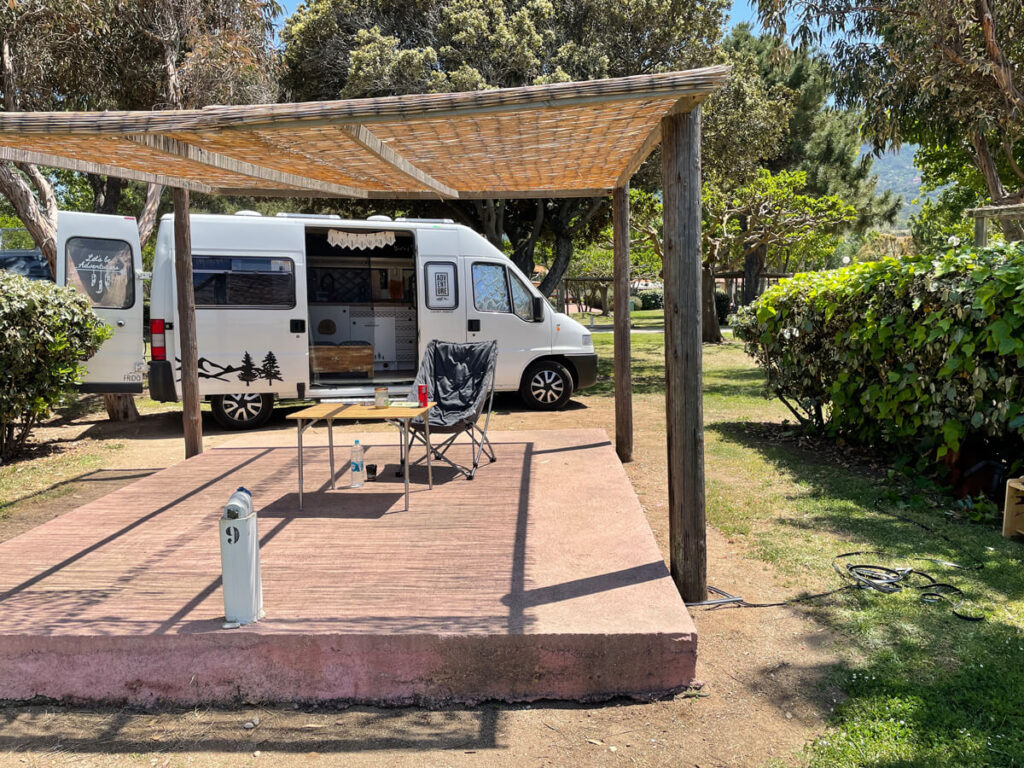
Stop 6: Abbartello
In the small town of Abbartello, we found a little paradise, which was certainly due to the off-season. We had an absolutely dreamy bay all to ourselves. In the evening, another woman traveling alone joined us with her camper, and we had a wonderful evening right on the beach.
You’ll find bays like this all the time, especially on the east coast, and in the off-season, the chances are pretty good that you’ll have them all to yourself. That was my only night where I wasn’t at a campsite. You can find more on this topic here: Campsites in Corsica.
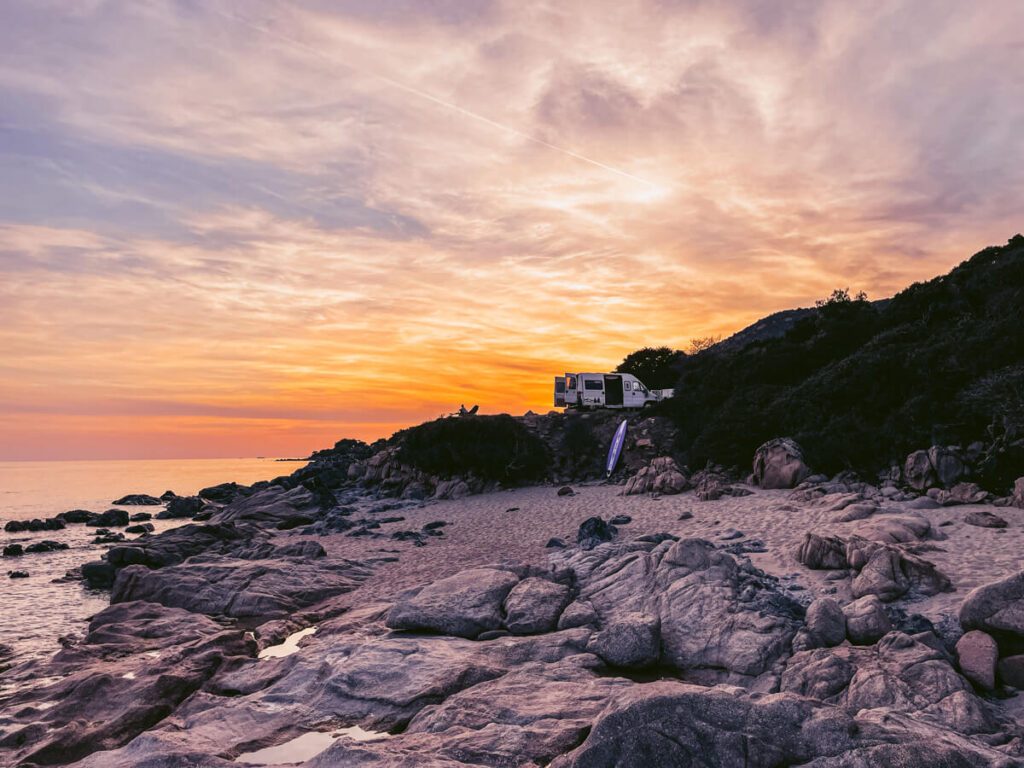
Stop 7: Plage de la Tonnara
Since I didn’t want to stay directly in Bonifacio, and the campsites there aren’t all that nice, I drove to the La Trinite campsite about 10 minutes earlier. There are great beaches to discover both towards Bonifacio and on the other side, and you can also reach Bonifacio in 10 minutes.
About a 5-minute drive (it’s difficult to walk) is the Tonnara Bay, which is also a popular kitesurfing spot. There are two dream beaches here: the Plage de la Tonnara and the Plage de Stagnolu (my personal favorite). To reach the second, you have to walk a bit through the dunes and reach a truly dream beach with very few people. If you’re traveling with a 4×4, you can certainly try to find a spot in the dunes.
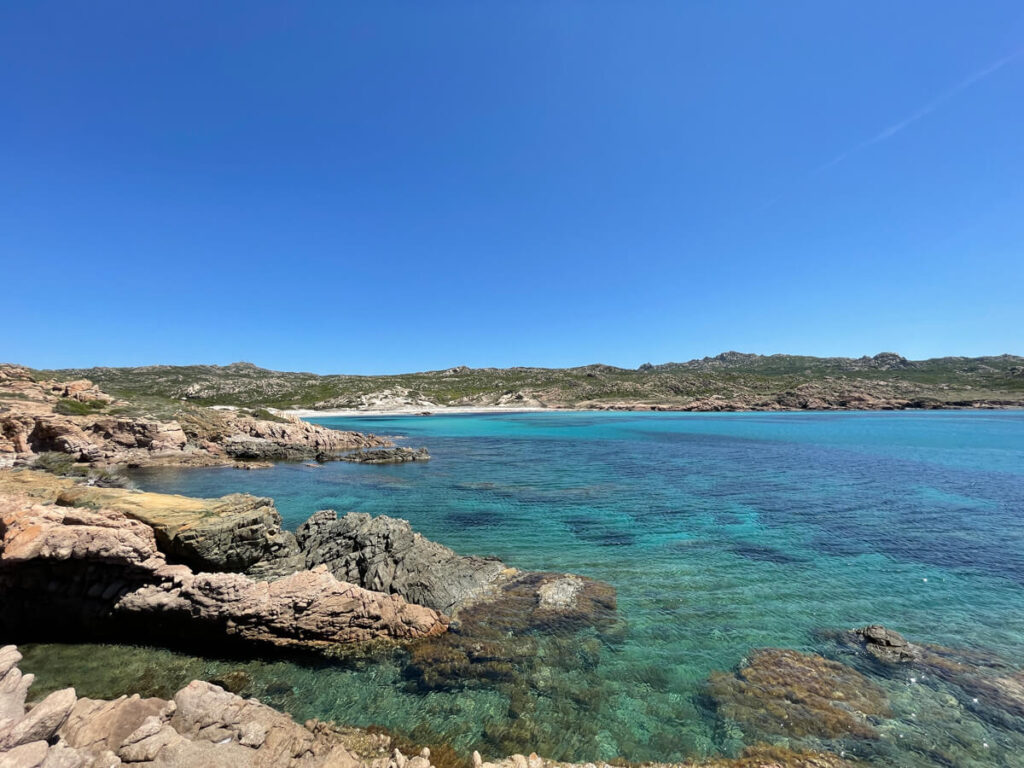 Powered by GetYourGuide
Powered by GetYourGuide
Stop 8: Bonifacio
I had actually chosen a parking lot in the city, but it was closed. After a somewhat longer search, I ended up on top of the rocks. There are also places there where you can easily park your camper. If you walk along the limestone cliffs, you will be rewarded with a gigantic view of the cliffs of Bonifacio, the city, and the sea. The coast of Sardinia is only 12 km away and clearly visible.
Bonifacio is located on the southern tip of Corsica and, thanks to its location high on the white chalk cliffs of a narrow peninsula, is arguably the most impressive fortress town in Corsica. I decided against visiting the town because of my dog (very narrow streets and lots of people). Unfortunately, it was far too hot that day to leave him in the camper. Therefore, for us, there was “only” the gigantic view of Bonifacio.
Popular tours from Bonifacio:
- Lavezzi Islands Half-Day Boat Tour*
- Bonifacio: Sunset Aperitif Dining Boat Tour*
- Guided Boat Tour and Snorkeling*
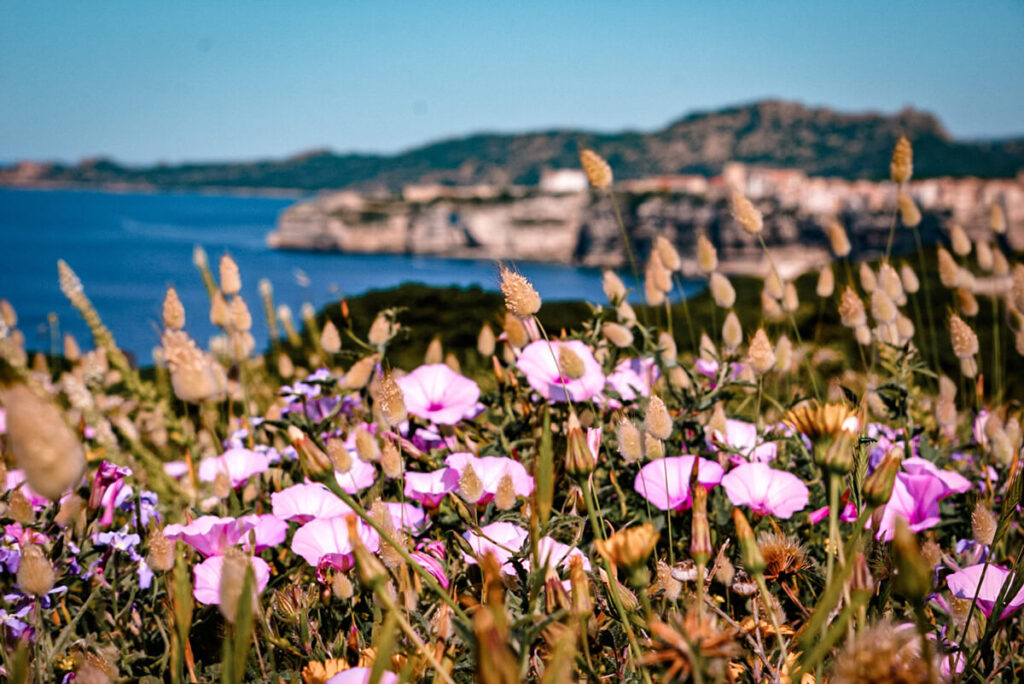
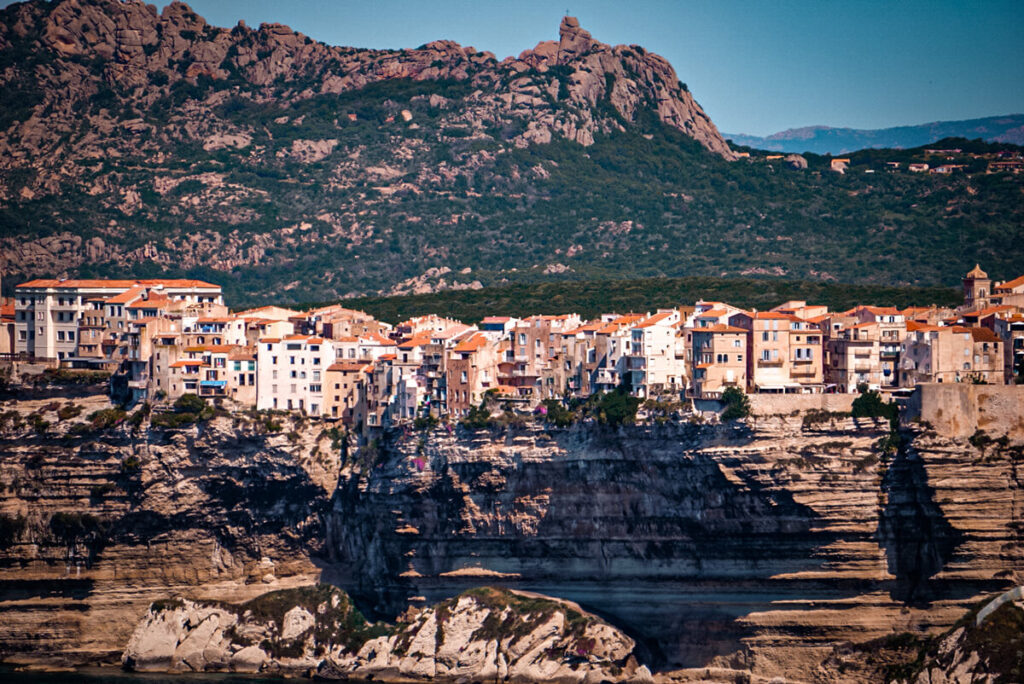
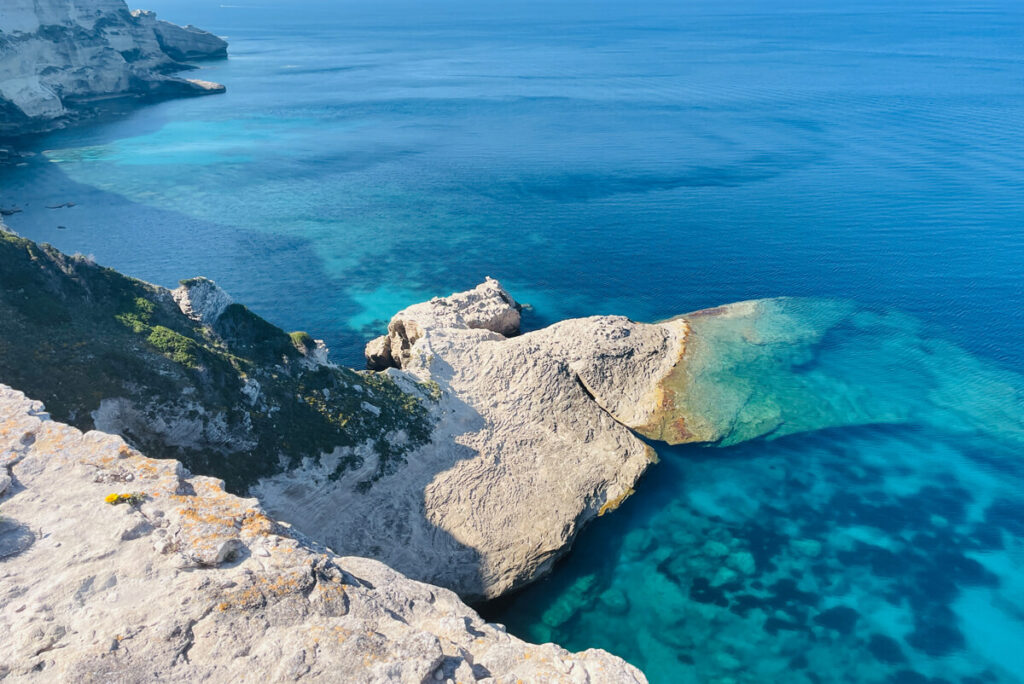
Stop 9: Rondinara
Once we left the T10, we arrived at the Rondinara Campsite. It’s a fairly large site, but quite winding and terraced under trees. After a 10-minute walk, you reach the Rondinara Bay and a stunningly beautiful white sandy beach. The scenery reminded me a bit of Thailand. There are other beaches nearby that can be explored. For the first time, there were a few more people on the beach, and the campsite was also well-visited.
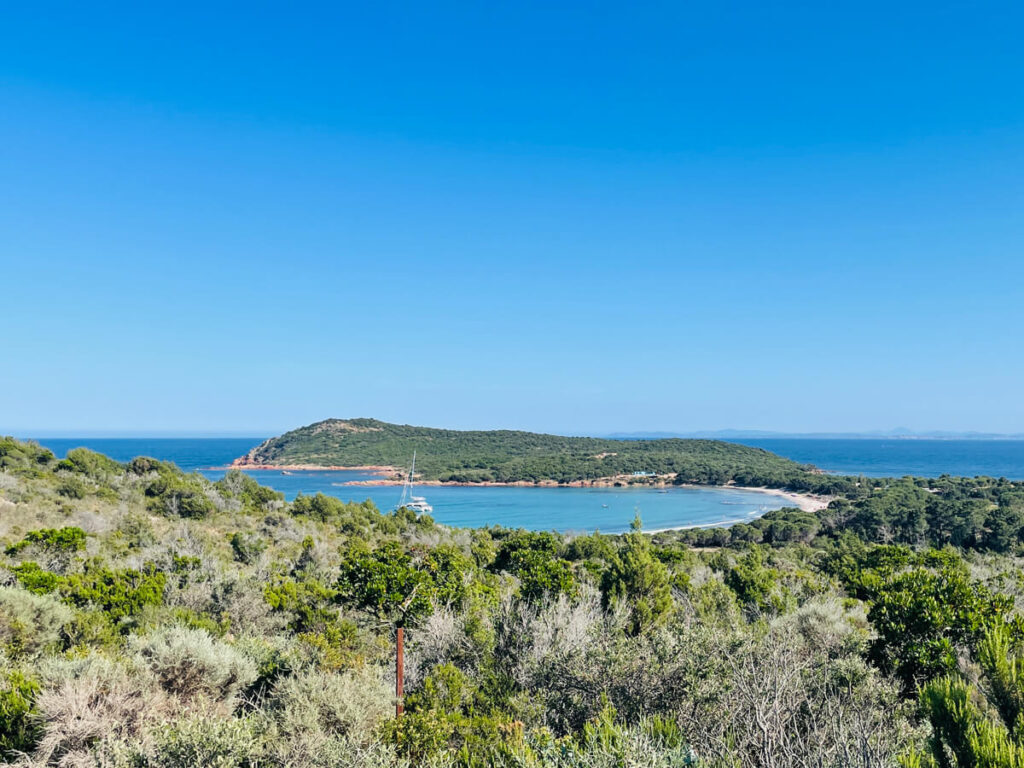
Stop 10: Fautea
The next morning, we continued on to Camping Fautea and the bay of the same name. You hear and read a lot about the campsite. It’s located on a small hill, and at the very top, there are only a few spots that offer great views of the bay. There are also many beaches all around that can be explored on foot.
There’s also an old tower directly behind the campsite that you can visit. However, I have to say that the beaches here weren’t that nice. When we were there, there was a lot of seaweed, which sometimes smelled very unpleasant, and there were only a few places where you could even get into the sea. However, the campsite also has its own small bay, which was very clean and made for a good entry with a SUP board.
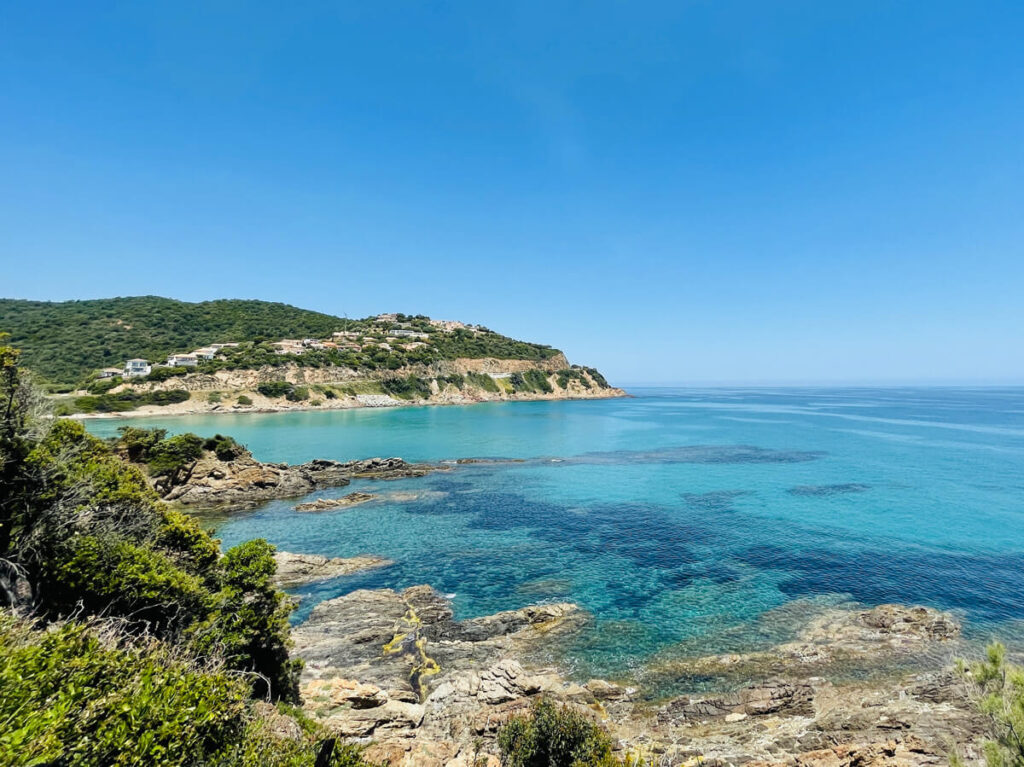
Stop 11: Solaro
We head back to the east coast, where you’ll find the typically long beaches. I chose this spot because of the campsite (Camping Cote des Nacres). A very relaxed spot with spots right on the beach. For us, it was the perfect place to slowly say goodbye to the island. Here, we could take long walks on the beach and simply relax a bit.
Stop 12: Aléria
Our last stop on the Corsica tour was the Capfun campsite in Aléria. It’s a relatively large facility right on the beach. The beach here is very beautiful and unspoiled. There’s a lot of driftwood lying around, which gives the beach a wild feel. The atmosphere is very relaxed, and I could easily have imagined staying here a few more days. A perfect end to our trip and after 16 days of fantastic weather, it even rained a little in the evening.
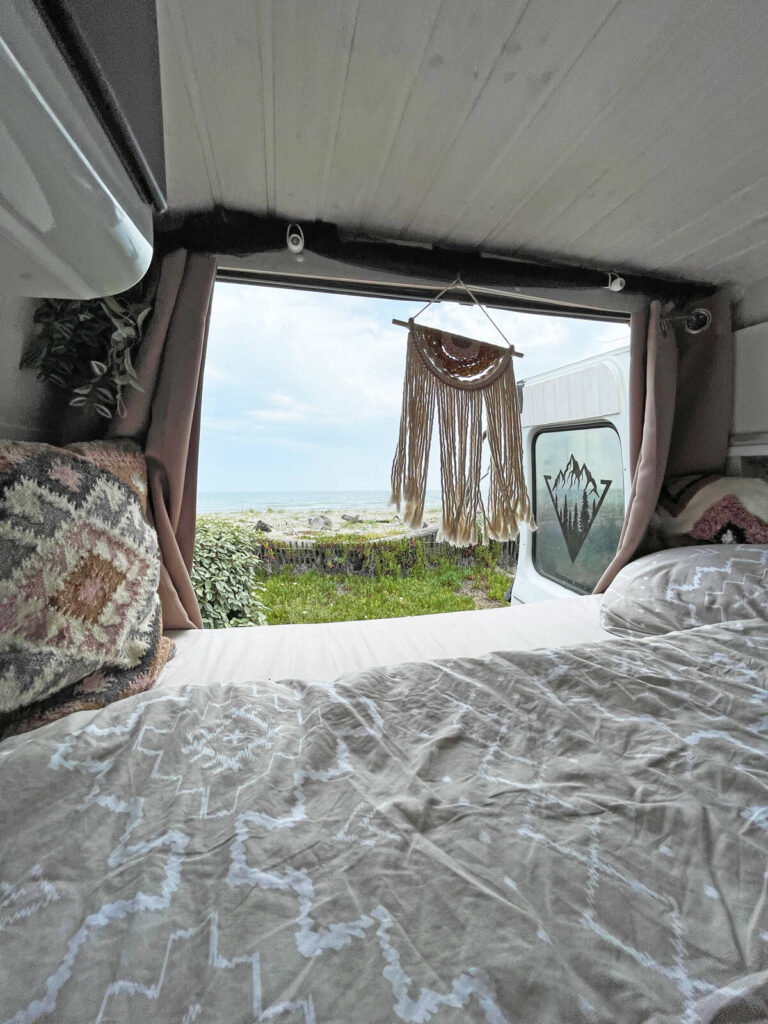
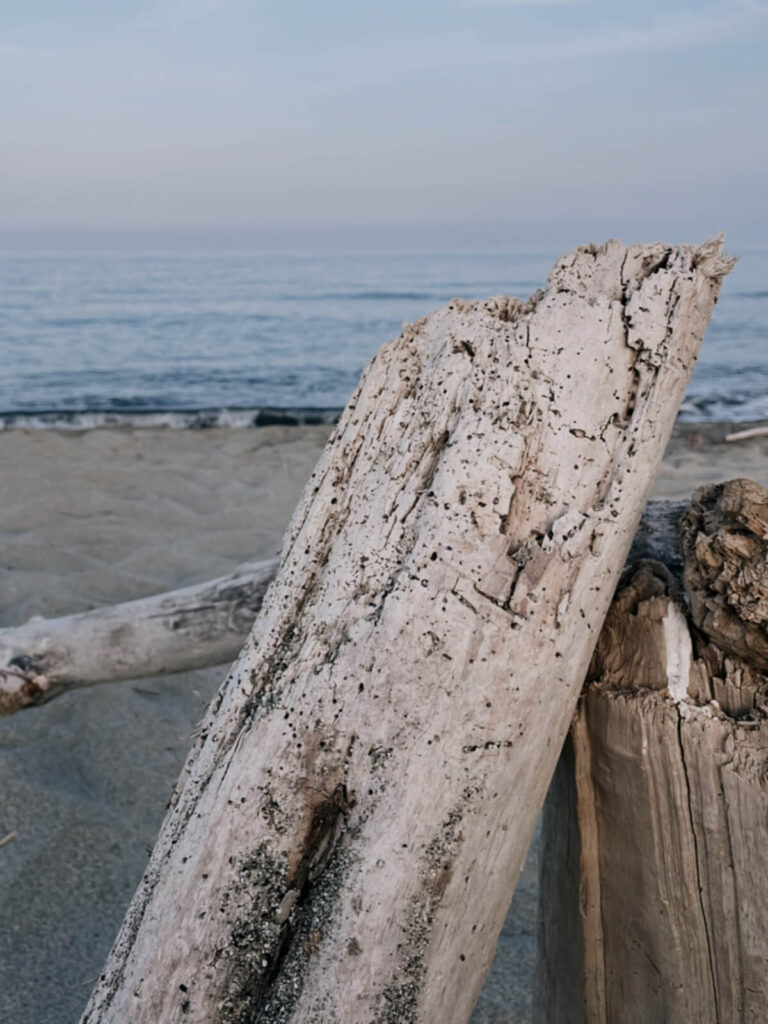
Arrival in Corsica
By plane
Most travelers arrive either by plane or, if traveling with their own vehicle, by ferry. During the peak travel season from May to October, there are numerous charter flights from Germany and Austria. There are four airports in Corsica: Calvi and Bastia in the north, and Ajaccio and Figari in the south.
Bastia and Calvi are served by various airlines (Air Corsica, Lufthansa, Peoples, Eurowings, and Easyjet), for example, from Berlin, Düsseldorf, and Cologne. To fly to the south, you have to fly to the airport in Geneva, Switzerland. You can get a round-trip flight from Germany for under €200.

Arriving by ferry
Corsica is served by ferries (Corisca Ferries or Moby Lines) from France, the Italian mainland, and Sardinia. For most travelers, the port of Genoa is the quickest to reach, but Livorno in Tuscany and Nice in France are also alternatives.
During peak season, ferries are completely booked, so it’s advisable to book ferry tickets from home. Buying tickets on-site is rarely cheaper than booking in advance. The shortest route is from Livorno to Bastia (4.5 hours).
When is the best time to travel to Corsica?
For us, and especially for my dog, who doesn’t like the heat, May was the perfect month to travel to Corsica. During the day, we had pleasant temperatures around 25°C. It cools down in the evening, and it’s not too warm in the morning. Furthermore, there was still very little going on on the island.
At the campsites, I always had a free choice of sites, and even when not all sites were open, I quickly found an alternative. The water temperature in May was also very pleasant for swimming.
In the off-season, it’s no problem at all to take your dog to the beach. During the high season, this can be a problem on some beaches, as it’s prohibited. A local told me that it’s impossible to walk your dog on the beach in July and August.
In my opinion, the best time to travel to Corsica is May and early June, as well as the end of September and October. During these times, the island is relaxed – both with a dog and with a camper.
How much does a Corsica tour cost?
How much a Corsica tour ultimately costs depends on your needs. While some prefer to stay in 5-star resorts, others prefer a much simpler experience. The type of trip, the length of your trip, and the month of your trip all play an important role. Furthermore, Corsica is not a particularly cheap travel destination. Also because many products have to be brought to the island. I have researched some prices for you below.
Prices in Corsica
- Flight: €200 to €400 per person
- Gas: €1.77 per liter of gasoline
- Rental car: €30 to €70 per day
- Bus tickets: €1 to €3 (depending on the route)
- Hotels: €80 to €150 per night
- Vacation apartment: €60 to €150 per night
- Campsites: €10 to €30 per night
- Eating in a restaurant: simple meal €10 to €20 | Upscale €20 to €40
- Activities: Hikes mostly free; museums & sights €5 – €10
- Water sports: €20 – €100
A “budget trip” for 7 days can cost €500 to €800 per person, a “mid-range trip” €800 to €1500. If luxury is important to you, you should expect to spend at least €1500. The actual costs can, of course, vary depending on individual preferences and travel conditions.
Packing list – What shouldn’t I forget?
If you’re planning a trip to Corsica, there are a few things you shouldn’t forget in your luggage. I have listed the most important things for you below:
Packing list for a Corsica round trip
- Summery, light clothing
- Sturdy shoes for excursions and hikes
- Headgear (cap, hat, scarf) and sunglasses
- Sunscreen with a high sun protection factor and Mosquito spray
- Water shoes* and dry bag* (especially for rocky beaches)
- USB hub* for charging devices
- Power bank* for charging on the go
- Daypack for excursions
- Travel credit cards for withdrawing money and paying in Oman
- Flashlight/headlamp for nighttime activities
- Quick-drying beach towel*
Travel guide for Corsica
We love travel guides and have been big fans of the DuMont series for many years. Countless travel guides are on our shelves here, and there are sure to be many more to come. For a Corsica tour, the DuMont travel guide* or the Corsica travel guide from Michael Müller Verlag* might be of interest. Both books provide numerous tips for planning your own trip.